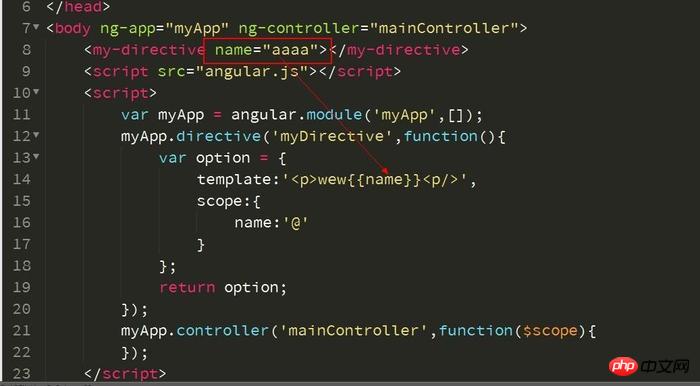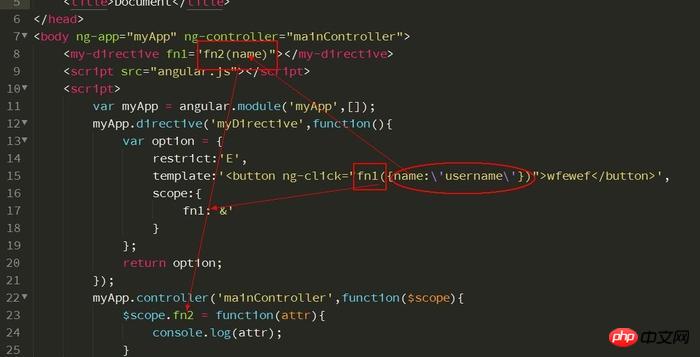Angular에서 독립적인 범위를 사용하는 개념
이번에는 각도 독립 스코프 사용에 대한 개념을 가져오겠습니다. 각도 독립 스코프 사용 시 주의사항은 무엇인가요? <!DOCTYPE html><html lang="en"><head>
<meta charset="UTF-8">
<title>Document</title></head><body ng-app="myApp" ng-controller="mainController">
<ceshi></ceshi>
<script src="angular.js"></script>
<script>
var myApp = angular.module('myApp',[]);
myApp.directive('ceshi',function(){ var option = {
template:'<p>{{abc}}</p>'
}; return option;
});
myApp.controller('mainController',function($scope){
$scope.abc = 'ericzheng';
}); </script></body></html>
내에서 여러 번 사용해야 합니다. 위 시나리오와 마찬가지로 입력 상자의 데이터를 변경하면 다른 태그의 데이터도 동시에 변경됩니다. 이는 분명히 현재로서는 독립적인 범위가 필요하지 않습니다.
독립적인 범위로 변환하려면 코드 한 줄만 필요합니다:
<!DOCTYPE html><html lang="en"><head>
<meta charset="UTF-8">
<title>Document</title></head><body ng-app="myApp" ng-controller="mainController">
<ceshi></ceshi>
<script src="angular.js"></script>
<script>
var myApp = angular.module('myApp',[]);
myApp.directive('ceshi',function(){ var option = {
template:'<p>{{abc}}</p>',
scope:{}
}; return option;
});
myApp.controller('mainController',function($scope){
$scope.abc = 'ericzheng';
}); </script></body></html>단방향
data 바인딩operator, 큰따옴표 안의 내용은 바인딩을 위한 문자열으로 처리됩니다. <!DOCTYPE html><html lang="en"><head>
<meta charset="UTF-8">
<title>Document</title></head><body ng-app="myApp" ng-controller="mainController">
<my-directive name="aaaa"></my-directive>
<script src="angular.js"></script>
<script>
var myApp = angular.module('myApp',[]);
myApp.directive('myDirective',function(){ var option = {
template:'<p>wew{{name}}<p/>',
scope:{
name:'@'
}
}; return option;
});
myApp.controller('mainController',function($scope){
}); </script></body></html>
 양방향 데이터 바인딩
양방향 데이터 바인딩
=연산자가 변수에 바인딩됩니다
<!DOCTYPE html><html lang="en"><head>
<meta charset="UTF-8">
<title>Document</title></head><body ng-app="myApp" ng-controller="mainController">
<input type="text" ng-model="abc">
<my-directive name="abc"></my-directive>
<script src="angular.js"></script>
<script>
var myApp = angular.module('myApp',[]);
myApp.directive('myDirective',function(){ var option = {
template:'<p>wew{{name}}<input ng-model="name"><p/>',
scope:{
name:'='
}
}; return option;
});
myApp.controller('mainController',function($scope){
$scope.abc = 'ericzheng';
}); </script></body></html>name=" abc"는 핵심입니다. 왼쪽 연결은 독립 범위이고 오른쪽 연결은 외부 범위의 모델 abc입니다
 상위 범위의 동작을 사용하세요
상위 범위의 동작을 사용하세요
& 연산자는 메소드입니다
<!DOCTYPE html><html lang="en"><head>
<meta charset="UTF-8">
<title>Document</title></head><body ng-app="myApp" ng-controller="mainController">
<my-directive fn1="fn2(name)"></my-directive>
<script ></script>
<script>
var myApp = angular.module('myApp',[]);
myApp.directive('myDirective',function(){ var option = { restrict:'E', template:'<button ng-click="fn1({name:\'username\'})">wfewef</button>', scope:{ fn1:'&'
}
}; return option;
});
myApp.controller('mainController',function($scope){
$scope.fn2 = function(attr){ console.log(attr);
}
}); </script></body></html> 이해하는 방법:
이해하는 방법:
이 기사의 사례를 읽은 후 방법을 마스터했다고 생각합니다. 더 흥미로운 정보를 보려면 PHP 중국어 웹사이트의 다른 관련 기사를 주목하세요!
추천 도서:
Angular에서scopel 지시어 사용에 대한 자세한 설명Angular Material 사용에 대한 자세한 설명Angularjs에서 $apply() 사용에 대한 자세한 설명위 내용은 Angular에서 독립적인 범위를 사용하는 개념의 상세 내용입니다. 자세한 내용은 PHP 중국어 웹사이트의 기타 관련 기사를 참조하세요!

핫 AI 도구

Undresser.AI Undress
사실적인 누드 사진을 만들기 위한 AI 기반 앱

AI Clothes Remover
사진에서 옷을 제거하는 온라인 AI 도구입니다.

Undress AI Tool
무료로 이미지를 벗다

Clothoff.io
AI 옷 제거제

AI Hentai Generator
AI Hentai를 무료로 생성하십시오.

인기 기사

뜨거운 도구

메모장++7.3.1
사용하기 쉬운 무료 코드 편집기

SublimeText3 중국어 버전
중국어 버전, 사용하기 매우 쉽습니다.

스튜디오 13.0.1 보내기
강력한 PHP 통합 개발 환경

드림위버 CS6
시각적 웹 개발 도구

SublimeText3 Mac 버전
신 수준의 코드 편집 소프트웨어(SublimeText3)

뜨거운 주제
 7490
7490
 15
15
 1377
1377
 52
52
 77
77
 11
11
 52
52
 19
19
 19
19
 41
41
 C 언어에서 typedef 구조체 사용법
May 09, 2024 am 10:15 AM
C 언어에서 typedef 구조체 사용법
May 09, 2024 am 10:15 AM
typedef struct는 C 언어에서 구조 사용을 단순화하기 위해 구조 유형 별칭을 만드는 데 사용됩니다. 구조 별칭을 지정하여 기존 구조에 새 데이터 유형의 별칭을 지정합니다. 향상된 가독성, 코드 재사용 및 유형 확인 등의 이점이 있습니다. 참고: 별칭을 사용하기 전에 구조를 정의해야 합니다. 별칭은 프로그램에서 고유해야 하며 선언된 범위 내에서만 유효해야 합니다.
 Java에서 예상되는 변수를 해결하는 방법
May 07, 2024 am 02:48 AM
Java에서 예상되는 변수를 해결하는 방법
May 07, 2024 am 02:48 AM
Java의 변수 예상 값 예외는 변수 초기화, null 값 사용, 지역 변수 범위 파악을 통해 해결할 수 있습니다.
 js 클로저의 장점과 단점
May 10, 2024 am 04:39 AM
js 클로저의 장점과 단점
May 10, 2024 am 04:39 AM
JavaScript 클로저의 장점에는 변수 범위 유지, 모듈식 코드 활성화, 실행 지연 및 이벤트 처리가 포함됩니다. 단점에는 메모리 누수, 복잡성 증가, 성능 오버헤드 및 범위 체인 효과가 포함됩니다.
 C++에서 include의 의미는 무엇입니까?
May 09, 2024 am 01:45 AM
C++에서 include의 의미는 무엇입니까?
May 09, 2024 am 01:45 AM
C++의 #include 전처리기 지시문은 외부 소스 파일의 내용을 현재 소스 파일에 삽입하고 해당 내용을 현재 소스 파일의 해당 위치에 복사합니다. 표준 입출력 함수를 포함하기 위한 #include <iostream>과 같이 코드에 필요한 선언이 포함된 헤더 파일을 포함하는 데 주로 사용됩니다.
 C++ 스마트 포인터: 수명 주기에 대한 포괄적인 분석
May 09, 2024 am 11:06 AM
C++ 스마트 포인터: 수명 주기에 대한 포괄적인 분석
May 09, 2024 am 11:06 AM
C++ 스마트 포인터의 수명 주기: 생성: 스마트 포인터는 메모리가 할당될 때 생성됩니다. 소유권 이전: 이동 작업을 통해 소유권을 이전합니다. 해제: 스마트 포인터가 범위를 벗어나거나 명시적으로 해제되면 메모리가 해제됩니다. 객체 소멸: 가리키는 객체가 소멸되면 스마트 포인터는 유효하지 않은 포인터가 됩니다.
 C++에서 함수 정의와 호출을 중첩할 수 있나요?
May 06, 2024 pm 06:36 PM
C++에서 함수 정의와 호출을 중첩할 수 있나요?
May 06, 2024 pm 06:36 PM
할 수 있다. C++에서는 중첩된 함수 정의 및 호출을 허용합니다. 외부 함수는 내장 함수를 정의할 수 있고 내부 함수는 범위 내에서 직접 호출할 수 있습니다. 중첩된 함수는 캡슐화, 재사용성 및 범위 제어를 향상시킵니다. 그러나 내부 함수는 외부 함수의 로컬 변수에 직접 액세스할 수 없으며 반환 값 유형은 외부 함수 선언과 일치해야 합니다.
 js에서 이것이 다음을 가리키는 여러 가지 상황이 있습니다.
May 06, 2024 pm 02:03 PM
js에서 이것이 다음을 가리키는 여러 가지 상황이 있습니다.
May 06, 2024 pm 02:03 PM
JavaScript에서 이 포인팅 유형은 다음을 포함합니다: 1. 전역 객체, 2. 함수 호출, 3. 생성자 호출, 5. 화살표 함수(외부 상속). 또한, 바인딩(), call() 및 apply() 메서드를 사용하여 이것이 가리키는 내용을 명시적으로 설정할 수 있습니다.
 vue에서 let과 var의 차이점
May 08, 2024 pm 04:21 PM
vue에서 let과 var의 차이점
May 08, 2024 pm 04:21 PM
Vue에서는 let과 var 사이에 변수를 선언할 때 범위에 차이가 있습니다. 범위: var에는 전역 범위가 있고 let에는 블록 수준 범위가 있습니다. 블록 수준 범위: var는 블록 수준 범위를 생성하지 않으며, 블록 수준 범위를 생성합니다. 재선언: var는 동일한 범위에 있는 변수의 재선언을 허용하지만 let은 허용하지 않습니다.




